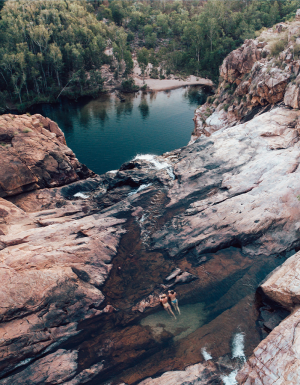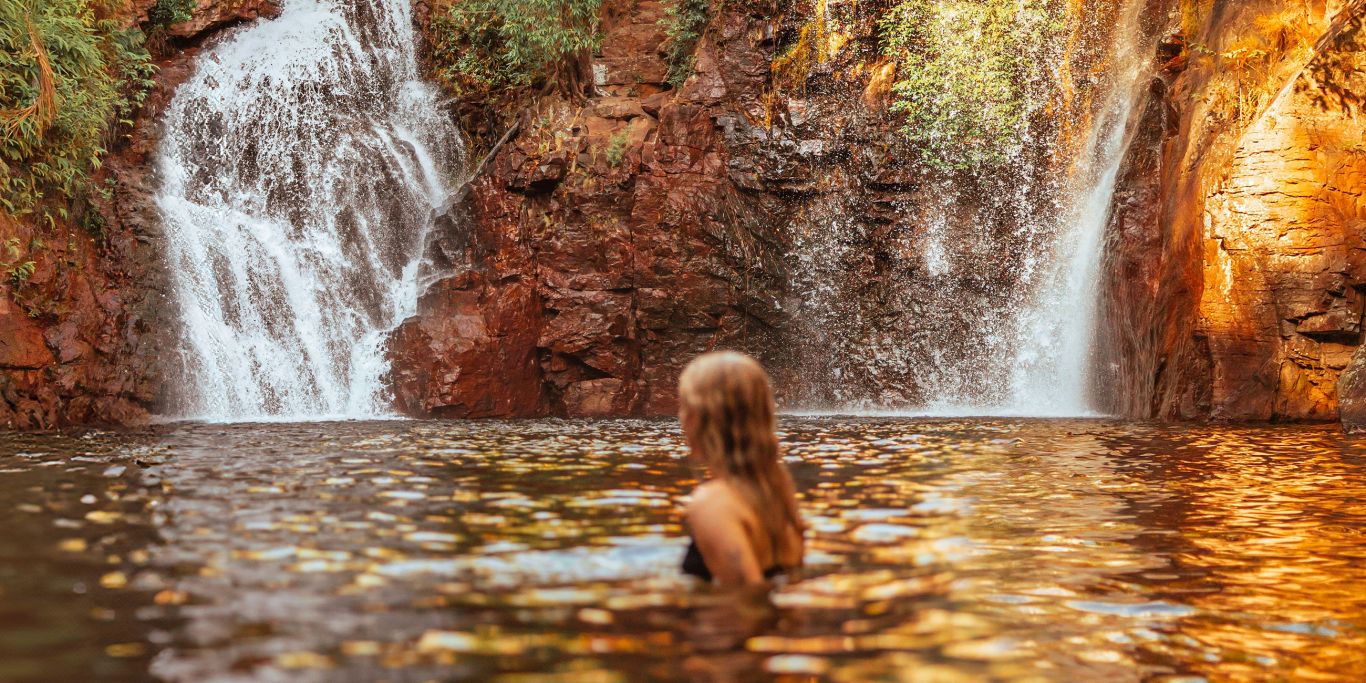Kakadu is not only steeped in natural beauty – it also holds 65,000 years of Indigenous history.
Choosing which tours to do in Kakadu National Park can be bamboozling, so we’ve taken the hard work out with this list of the best tours in Kakadu.
The Traditional Owners are the Bininj in the north of Kakadu and the Mungguy in the south. The landscape heaves with life, both cultural and natural, and contains a multitude of spiritual sites.
There are plenty of tours in Kakadu that offer incredible insights into the land and local culture. Where possible, it’s a great idea to seek out Indigenous-owned businesses and tour guides, as Aboriginal people hold the knowledge, stories and culture of the region and have done so for many millennia.
It’s worth noting that to enter Kakadu, you’ll need to purchase a Parks Pass , which can be organised online, or bought at one of the locations listed on Parks Australia’s website. Once you’ve got that sorted, here are the best tours in Kakadu to explore.
1. Yellow Water Cruises
Best for: Families and wildlife lovers
The Yellow Water Cruise is one of the most iconic tours in Kakadu and operates year-round out of Cooinda Lodge (one of Kakadu’s most popular accommodation offerings). The landscape is ever-changing depending on the season, so no two cruises will be the same.

The wetlands are truly spectacular, and you’ll spot birdlife in abundance. Kakadu is home to around one-third of Australia’s bird species, and on the Yellow Water Billabong is a great place to witness jabiru, sea eagles, magpie geese and egrets. Take the tour at dawn or dusk when the wildlife is more active.

Price: Starting from $105 per person for a 1.5-hour cruise
2. Guluyambi Cultural Cruise
Best for: Travellers seeking a cultural experience
From a small dock not far from Ubirr, you will venture to the Arnhem Land side of the East Alligator River on a small covered boat cruise. This is an intimate tour where an Aboriginal guide will share local culture, stories and mythology.

This Aboriginal reserve is otherwise inaccessible to tourists unless you have a permit. However, as guests of the Traditional Owners on this tour, you can venture where most cannot. Expect to see some impressively large crocodiles, sandy beaches and ancient rock art.
Price: $89 for a one-hour and 45-minute cruise
3. Rock art tours
Best for: Families and travellers curious about Indigenous history and spirituality.
Kakadu holds thousands of rock art sites , which are some of the oldest records of any group of people in the world. The two most famous rock art sites in Kakadu are Ubirr and Burrungkuy (Nourlangie). Here, you’ll find enigmatic depictions of animals, spirits and Indigenous Creation Ancestors.

If you’re interested in learning about local Indigenous culture, a taking tour of Kakadu’s rock art is one of the best things to do in the national park.
The local Bininj guides of Yibekka Rock Art Tours lead tours to Burrungkuy, sharing the incredible stories behind the rock art as well as the Dreaming stories held within the landscape.

For groups looking to enrich their experience in Kakadu, take a cultural tour of Ubirr and/or Burrungkuy with Ayal Aboriginal Tours , where your knowledgeable guide will interpret the landscape and images you’re witnessing.

Price: For Yibekka Tours, enquire about pricing on their website. For Ayal Aboriginal Tours, a private guide for 90 minutes starts at $550 for groups of up to 12 people.
4. Ranger-guided walks, talks and workshops
Best for: Families and travellers curious about Indigenous history and spirituality
One of the best things about Kakadu is that its most popular walking trails are staffed by park rangers who, during the dry season, give guided tours for free. The tours are part of Kakadu’s interpretive program, which includes guided walks, slideshows in certain campgrounds, art site talks and cultural demonstrations like pandanus weaving and Indigenous painting techniques.
The program schedule changes each dry season, so stay up to date with The Parks’ schedule of ranger-guided activities . Attending is free, but you must book online. For more information, contact the Bowali Visitor Centre, which can be contacted on 08 8938 1120

Price: Free
5. Wildlife safari
Best for: Immersing yourself in Aboriginal culture
Animal Tracks is a seven-hour wildlife safari and fascinating Aboriginal cultural tour in a 4WD bus that runs in the dry season.
You’ll hunt and forage ingredients for your dinner, then cook them to eat while watching the sunset over a billabong alive with bird life. Animal Tracks has exclusive access to some areas of wetlands and woodlands, with a maximum of 18 guests and led by an expert Aboriginal guide.

Price: From $240
6. Scenic flights
Best for: Travellers with an adventurous streak
A scenic flight in Kakadu is an unforgettable experience. Get a new perspective of the floodplains and escarpments from the air, especially in the wet season. Feel like you’re in an action movie as you soar over savanna woodlands in a doorless helicopter, whizzing past magnificent waterfalls and darting through canyons.

Kakadu Air Services offer scenic flights options (helicopter of fixed-wing aircrafts) that last between 20 minutes and an hour. Visitors can truly kick back and take in the landscape from the ultimate vantage point. If you’re short on time, Kakadu Air Services also offer a Darwin to Kakadu day trip via helicopter that takes in a few of the key attractions, as well as unparalleled vistas of the landscape. The tour returns to Darwin at 4pm on the same day.

Price: From $159 for a half-hour fixed-wing flight.
7. 4WD tours
Best for: Travellers looking to get off the beaten path (literally).
A four-wheel-drive tour of Kakadu allows visitors to get right into the heart of the National Park, and access areas way off the beaten track.
If you’re looking for unique cultural insights, the Traditional Owners that run Kakadu Cultural Tours have access to exclusive sites in Northern Kakadu and Arnhem Land. Arnhemlander is an exceptional day tour into Western Arnhem Land.

Or perhaps you’d like to a few days with Sab Lord – a legend in the Northern Territory known as a classic outback character. Sab’s Lords Safaris take day and multi-day tours into Kakadu. His family owned and operated the last pastoral land that later became part of Kakadu National Park and Sab has maintained his connection to the land.
Price: The Arnhemlander starts from $302. Enquire here for Lord’s Safari’s multi-day tour pricing.
8. Fishing trips
Best for: Fishing fanatics
The wet season displaces millions of litres of water, making Kakadu a fishing hotspot. After the wet season, barramundi (alongside other fish) collect in certain areas, including Yellow Water, South and East Alligator River, Sandy Billabong, and Two- and Four-Mile Holes.
Fishing in Kakadu requires a licence, but if you don’t have one (or don’t want the hassle of hiring your boat and 4WD), you can join a local fishing tour. Some operators like Kakadu Fishing Tours run day tours from Darwin to Kakadu.
Otherwise, there are a few options if you’d like to add some fishing to your itinerary while in the park. Kakadu Fishing Tours also runs a charter service that can go anywhere you like.
Cooinda Lodge offers Yellow Water Fishing Tours on the beautiful Yellow Water Billabong. Bamurru Lodge, a luxury property nearby Kakadu, turns exclusively into a dedicated barramundi fishing lodge during the run-off.

Price: Yellow Water Fishing Tours are from $260 per person including all fishing gear and cold drinks.
9. Day trips from Darwin
Best for: Travellers short on time, travellers without a car, or travellers who want to kick back and let someone else take care of the planning.
Take away the stress of organising your visit to Kakadu with either a day trip or a multi-day tour from Darwin. We recommend more than one day to truly take in all the region has to offer, but if time is a luxury you don’t have, then there are a few options.
A scenic flight tour of Kakadu from Darwin will save you the most time, stopping off at a few key attractions before returning to Darwin in the afternoon.
Or, set out bright and early for a day tour of Kakadu from Darwin via coach with AAT Kings . If you’ve got a bit more time on your hands, then Intrepid Tours offer a multi-day Darwin to Kakadu tour that takes in the very best the Top End has to offer.

Price: Day tours via air start at $899 with Kakadu Air Services. A day tour via coach starts at $399 with AAT Kings. Check Intrepid for their schedule of tours and pricing .
















